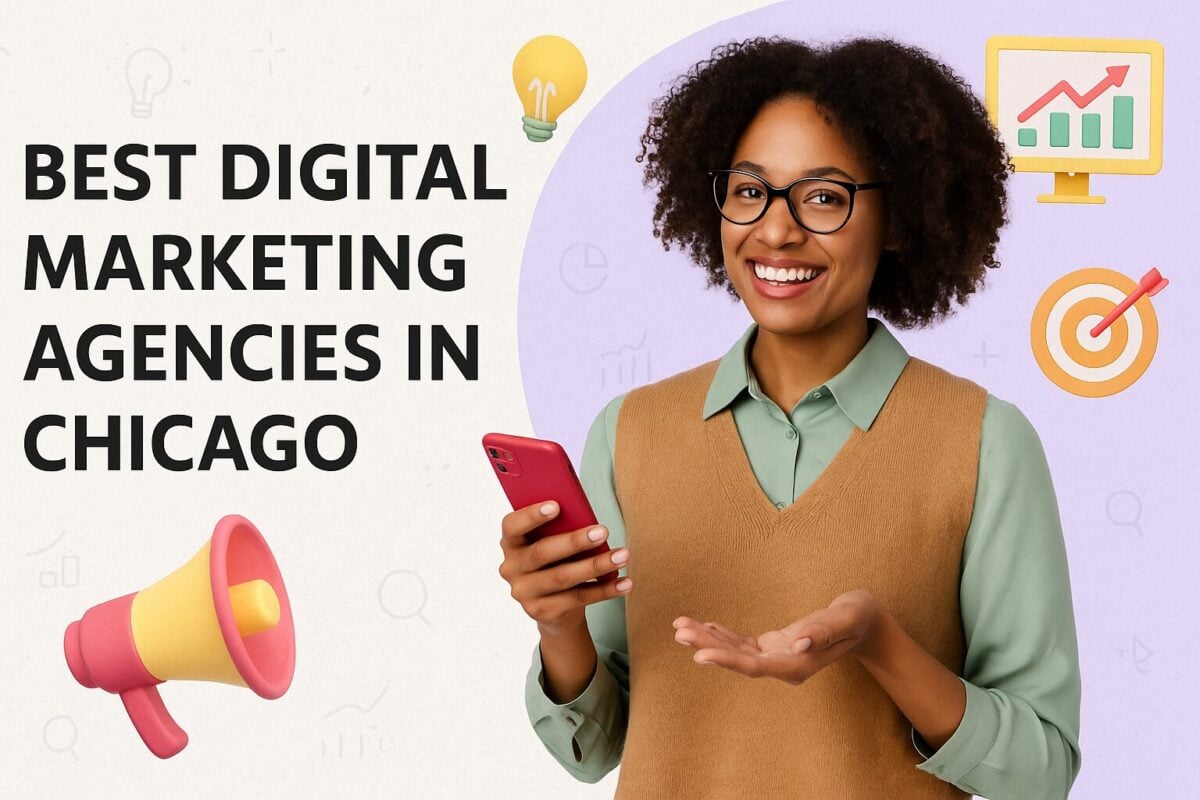With increasing internet use and the emergence of new channels and platforms, having a website alone isn’t enough. You need to create opportunities for people to engage with your brand across these various digital channels or you’re going to miss out on valuable sales. That’s why it pays to invest in omnichannel digital marketing to ensure that your customers have a cohesive experience no matter which channel they use.
In this guide, we explore what omnichannel digital marketing is and why it’s important for brands. We also discuss best practices to follow and provide you with several brand examples to help you get started with omnichannel digital marketing.
Understanding Omnichannel Digital Marketing and How to Get Started:
What is Omnichannel Digital Marketing?
Omnichannel digital marketing is the practice of maintaining a brand presence across various digital channels and ensuring a cohesive experience throughout those touchpoints. It involves the use of unified messaging and marketing collateral to promote your products and services across all these channels.
For example, if your website homepage is currently promoting your latest Valentine’s Day collection, the same collection should be highlighted prominently across your social media pages. That’s exactly what ColourPop Cosmetics did with their Lost in Love collection. You can see their website homepage splashed with a banner promoting the collection, under which customers have the option to instantly shop the collection.

Source: colourpop.com
Similarly, on their Instagram page, the brand shares Reels, makeup inspo, and product close-ups based on the collection. One look at their feed and you can instantly get the same feel as their website’s current homepage.
Omnichannel Digital Marketing vs. Omnichannel Marketing
In a previous post, we extensively covered the topic of omnichannel marketing. And you may be wondering how it’s different from the topic at hand. Omnichannel marketing aims to create a cohesive and consistent experience across every touch point and includes both digital and traditional or offline channels. Meanwhile, omnichannel digital marketing focuses only on digital marketing channels.
Omnichannel Digital Marketing Channels
As explained above, omnichannel digital marketing focuses exclusively on digital channels. These channels include:
- Website – Your website serves as a digital storefront for customers to browse your products, learn more about your business, and make purchases. You can prepare your website for omnichannel digital marketing by providing tools that will enhance the customer’s shopping experience.
For instance, Shiseido enriches the website experience with tools like a 3-minute skin analysis, product finders, and virtual consultations. They even provide an auto-replenishment service so customers never run out of their favorite products.
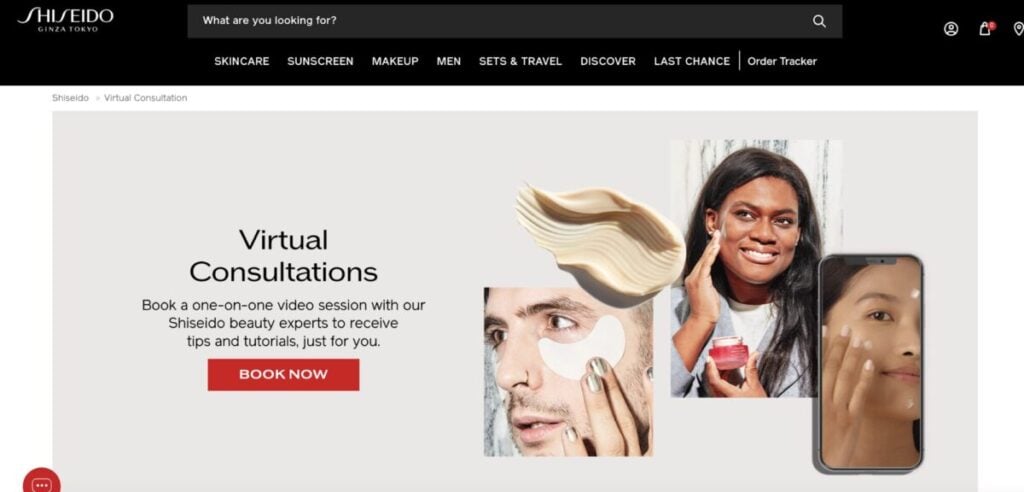
Source: shiseido.com
- Social media – Leading social media platforms like Instagram, Facebook, TikTok, etc. provide you with a channel to connect with your audience. They not only allow you to share content but also open up a two-way communication channel. You can also use these platforms to run targeted ads and provide customer service.
- Ecommerce marketplaces – Marketplaces on ecommerce platforms like Amazon and eBay offer an additional channel to expand your brand’s digital presence. They allow you to tap into the existing customer base of these platforms. You can incorporate these into your omnichannel digital marketing strategy by creating an experience consistent with your brand’s website. For example, check out the GoPro Amazon storefront that gives you a look and feel similar to the official GoPro website.

Source: amazon.com
- Mobile apps – Brands can also build their own mobile app to deliver a seamless customer experience. These apps can streamline the browsing and buying experience for mobile users.
- Email – You can use email marketing to deliver personalized communication in the form of product recommendations, updates, and promotional offers. SELSEY, for instance, experimented with abandoned cart emails and experienced significant conversion growth. Users who abandoned their cart received automatic reminder messages featuring reviews from happy customers complete with a discount code.

Source: getresponse.com
- Chatbots – AI-powered chatbots, typically deployed through websites and social media platforms, can facilitate real-time support and assistance to customers. Check out Sprout’s Twitter chatbot, which gives you an appropriate response based on several pre-existing prompts.
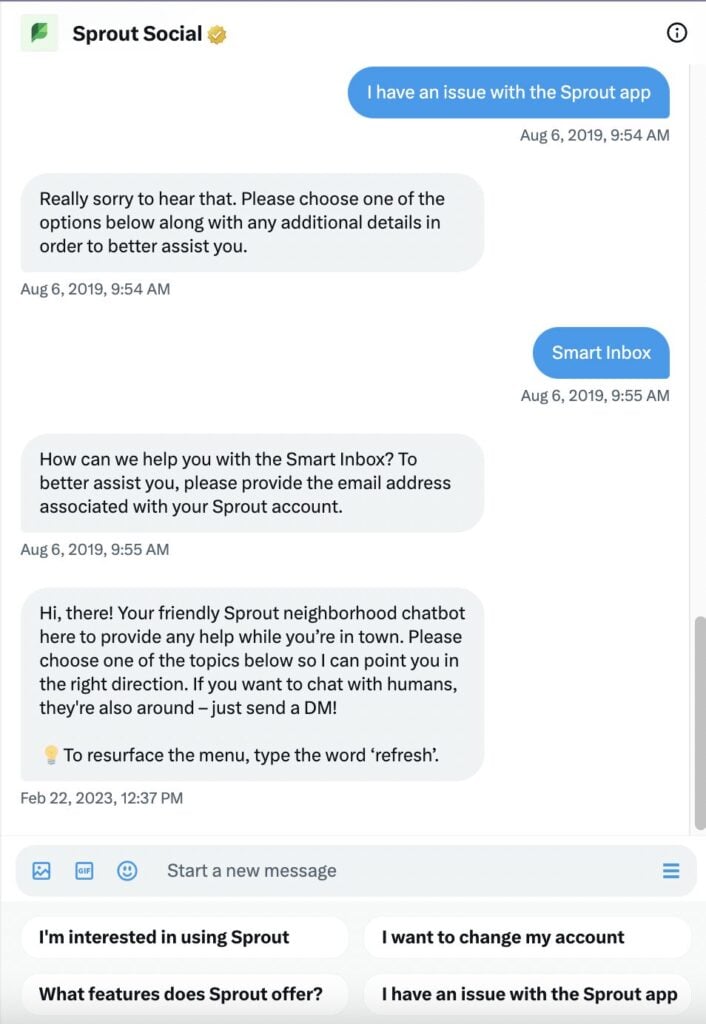
- Display advertising – You can also use display ads on websites and social media to engage your target audience with the right offers at the right time.
- Push notifications – Mobile app users can be engaged through time-sensitive alerts, updates, and promotions delivered through push notifications. H&M, for instance, sends push notifications based on recent purchases and provides appropriate recommendations.
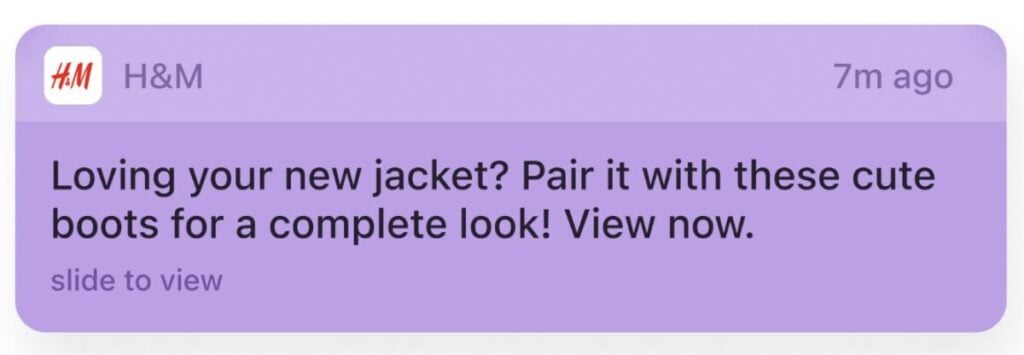
Source: sendbird.com
Why You Need Omnichannel Digital Marketing
So what’s the big deal with omnichannel digital marketing? Let’s explore some of the key benefits of creating a cohesive omnichannel experience.
Enhance Customer Satisfaction
Providing your customers with multiple methods to connect with your business ultimately enhances their experience. Omnichannel digital marketing creates more opportunities to address their needs effectively, enabling you to enhance customer satisfaction. For instance, even if they’re unable to use the phone, they can turn to your social media page to get the support they need. Or they can complete a purchase right within the mobile app even while on the go.
Expand Your Reach
Omnichannel digital marketing enables you to maintain a brand presence across every available digital channel. This means you can reach your customers where they are, instead of requiring them to search for you or come to you. As such, you can effectively expand your reach by getting your brand in front of people no matter which channel they prefer. For example, someone who mostly uses social media can get support right there without having to make a call or send an email.
Drive More Profits
Finally, omnichannel digital marketing contributes directly to your bottom line. By creating more opportunities for people to interact with your business, you’re making it easier for them to find your products and buy them. Similarly, you can easily engage existing customers to buy more products or renew their subscriptions. As a result, you can experience increased sales, which will subsequently drive more profits.
Best Practices to Build a Seamless Omnichannel Experience
Getting started with omnichannel digital marketing can seem challenging and overwhelming at first glance. So here are a few best practices that will help you build a seamless omnichannel experience.
1. Start Small and Fan Out
While it’s ideal to maintain a brand presence across all available digital channels, you don’t necessarily need to have all your bases covered right from the start. The process of creating an omnichannel digital experience is challenging and time-consuming.
So it’s best if you start small by focusing on just the essential channels and then fanning out later on. This will allow you to perfect the omnichannel experience first with the opportunity to expand instead of trying to juggle too many channels imperfectly.
We recommend starting out with the most crucial channels: your website and social media. Focus on creating a seamless omnichannel experience across these touchpoints first and then add more channels if needed. This may involve expanding to an ecommerce marketplace and even creating an app.
For instance, Nordstrom started building their digital presence in 1998. But they only launched an app in 2011 after already having a solid online presence. Customers can use the app to get alerts about new drops, sales, and stock updates. It allows seamless order tracking and simplifies the reward redemption process.
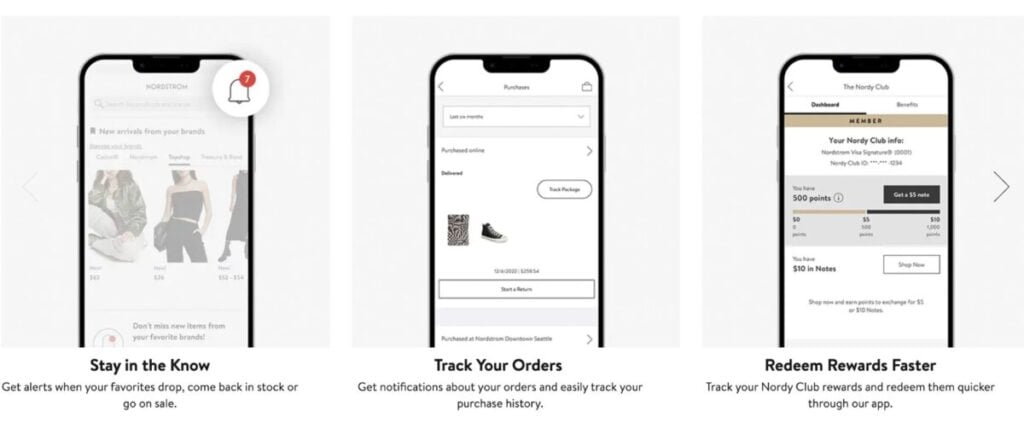
Source: nordstrom.com
2. Use Data to Inform Your Strategy
Data is your best friend when it comes to building a successful omnichannel digital marketing strategy. Thankfully, digital channels offer a wealth of data that you can use to inform different aspects of your strategy. This data can help you identify opportunities to improve various omnichannel touchpoints and create a coherent experience for your customers.
You can combine multiple data sources such as your social media analytics, CRM, website analytics, email marketing analytics, and mobile app data to gain a better understanding of your customers. These insights will then give you a better idea of how to create experiences that address their needs and challenges.
For example, if you notice a high churn rate among visitors coming from social media, you might want to review the links you share on social media. Are they accompanied by relevant copy? Does the landing page match what’s being offered in the copy?
3. Create Relevant Customer Segments
As consistent as your omnichannel experience may be, it won’t have that big of an impact if it’s not relevant to the individual customer. This is why it’s crucial to create customer segments so you can plan an omnichannel experience that’s personalized for each group. The data you’ve collected can be used to group customers into different segments. You can look into common behaviors and buying patterns to categorize your customers and create relevant segments accordingly.
For instance, you may have a segment of high-value customers who make huge purchases at a time and a segment of customers who stop buying after their purchase. Additionally, you may have a segment of loyal customers who regularly buy from your business as well as a segment of customers who add something to their carts and leave without buying anything.
Accordingly, you can come up with a strategy to reach and engage these different customer segments with personalized offers and messaging. For example, the segment of customers with abandoned carts may be engaged through retargeting campaigns and email reminders. Meanwhile, a segment of new customers who recently made a purchase may be encouraged to make a repeat purchase with special discount coupons via email. Here’s an example from SpooksieBoo.
4. Maintain Continuity in Communication
The easiest part of omnichannel digital marketing is creating a consistent look and feel across your channels. Similarly, sharing consistent and coherent messaging across these channels isn’t too difficult either. The challenge begins when you need to maintain continuity in your communication so that customers can seamlessly enjoy a continuous experience even if they switch between channels.
That means they should be able to easily pick up where they left off when they switch from social media to your website or from your website to your app and so on. At the most basic level, this would require directing them to the right landing pages regardless of where they came from. For example, ensure that when people come across an ad for a specific product on social media, the link they click takes them to a page where they can buy that exact product.
Similarly, make sure your team can easily access necessary customer data so they can continue the conversation across various channels. This includes access to conversation history that would provide context and prevent the need for customers to keep repeating themselves over and over again. Someone who contacted your social media support shouldn’t have to explain the issue all over again when your support team reaches out to them via the phone.
Solutions such as LiveAgent come with a chat history feature that provides your team with access to valuable information about customer conversation history. This means they can quickly find information about a customer’s previous inquiries and prior solutions to an issue. They can even see which website a customer is researching so your team can provide appropriate information.

Source: liveagent.com
5. Leverage the Right Automation Tools
Omnichannel digital marketing is easier than ever with the development of omnichannel marketing tools that can help you automate some of your processes. These tools can automate data collection and analytics as well as personalization by integrating with multiple channels.
Platforms like ActiveCampaign, for instance, come with robust ecommerce automation tools to support your omnichannel strategy. You can use it to create tailored shopping experiences on your website with personalized product recommendations. Meanwhile, you can create automation workflows to send timely follow-up emails based on customer action. For instance, customers automatically get emails asking them to check out products similar to what they’ve recently purchased.
ActiveCampaign automatically analyzes cart abandonment to look for issues in the buying process so you can optimize the shopping experience. Further, the abandoned cart recovery feature automates the process of recapturing potentially lost sales to drive more conversions.

Source: activecampaign.com
Take Your Omnichannel Digital Marketing to the Next Level
From enhancing the customer experience to boosting profits – omnichannel digital marketing can bring positive changes to your business. Use the tips and brand examples highlighted above to get started with your own strategy.
Frequently Asked Questions
What is omnichannel in digital marketing?
In digital marketing, omnichannel refers to a seamless integration of multiple digital touchpoints to create a cohesive customer experience.
What is omnichannel vs. multichannel digital marketing?
Both omnichannel and multichannel make use of multiple marketing channels. The difference is that the experiences are cohesive and interconnected in omnichannel whereas multichannel offers a more disjointed experience.
What is an omnichannel example?
An omnichannel example is a customer discovering your product through an Instagram ad and visiting your website through the given link and then receiving an email follow-up if they abandon their purchase.
What is the difference between digital and omnichannel?
Digital refers to the use of online channels such as websites, email, and social media whereas omnichannel refers to the integration of those channels.
Is omnichannel the same as ecommerce?
Ecommerce is a part of omnichannel but the two terms can’t be used interchangeably.


